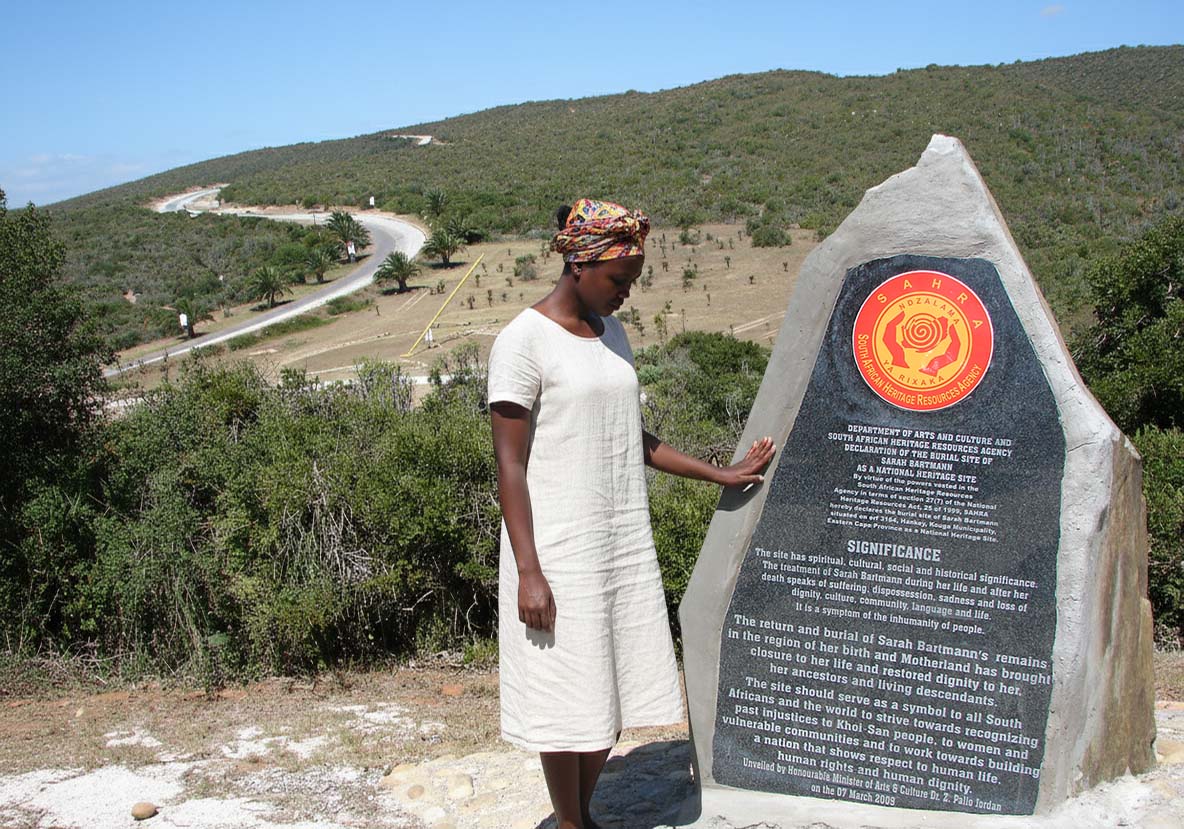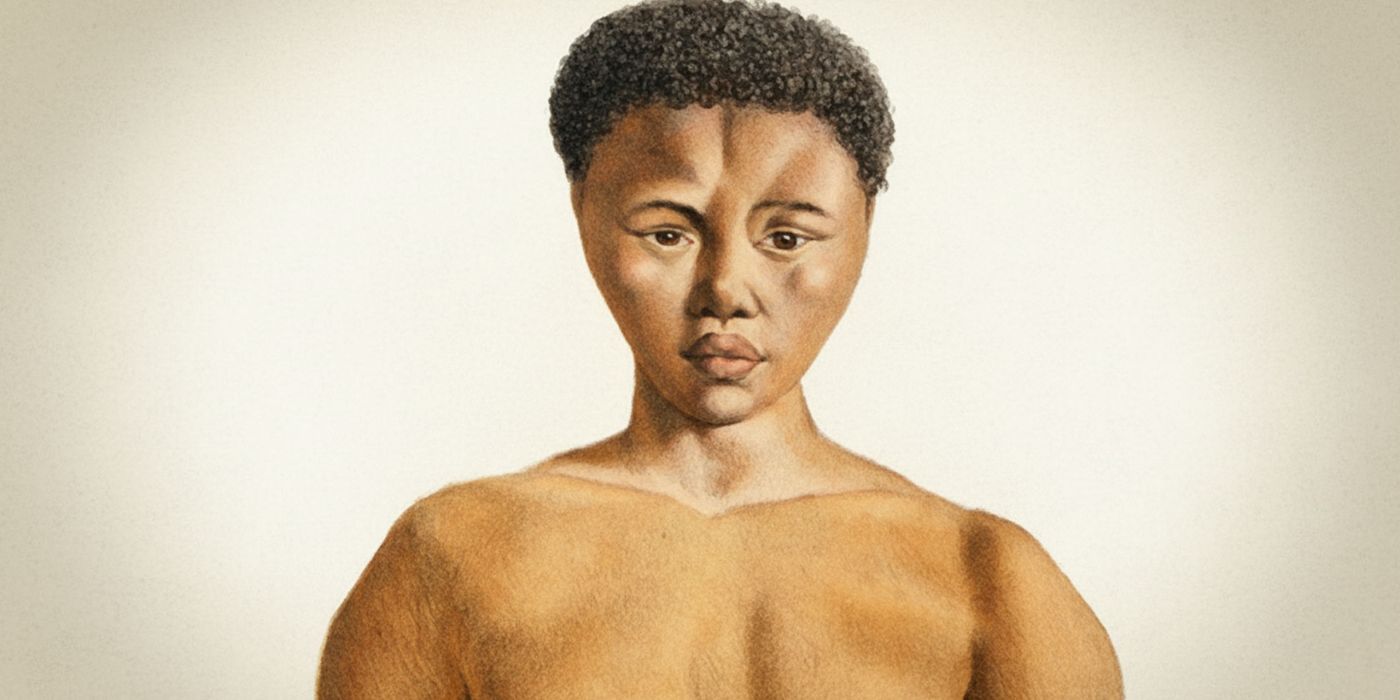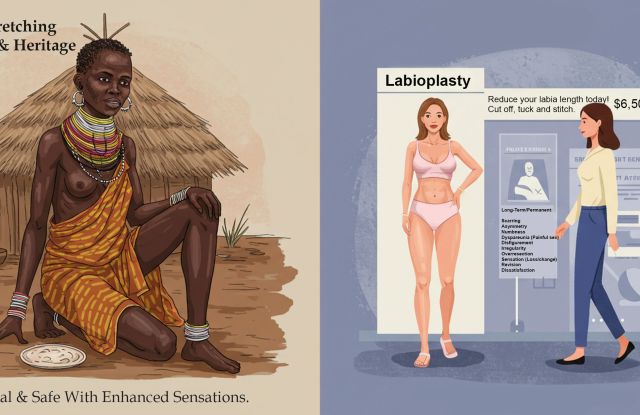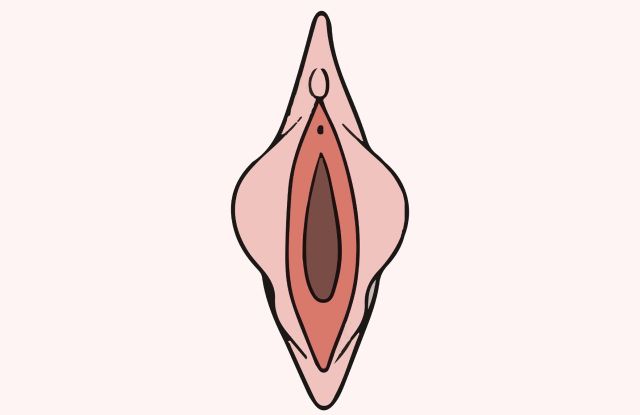The Hottentot Venus was the derogatory colonial name given to Sarah Baartman (also known as Saartjie), a Khoikhoi woman from the Eastern Cape of South Africa.
The term "Hottentot" is an archaic and offensive slur for the Khoikhoi people, who belong to the broader Khoisan group. Exhibited across Europe in the early 19th century due to her distinctive anatomy, Baartman was ruthlessly exploited as a symbol of racial difference, an act which fueled and validated the prevailing racist and pseudo-scientific theories of the era.
Sarah Baartman was born around 1789 near the Gamtoos River, in what is now the Eastern Cape of South Africa. Her early life was defined by the violence and instability of the colonial frontier. She was tragically orphaned at a young age during a commando raid that devastated her community. Her birth name and exact date of birth remain lost to history. She eventually took the name Sarah Baartman and, after her family’s demise, was forced into servitude, working as an enslaved domestic servant for a Dutch boer (farmer) near Cape Town. During this time, she married a Khoikhoi man and had a child who died shortly after birth, compounding the hardships she endured.
The Lure of Europe and the Act of Betrayal
Her fate was irrevocably sealed in 1810 by the manipulative proposal of William Dunlop, a British military surgeon, and her owner at the time, Hendrik Cesars. They recognized the commercial value of her physical appearance in a Europe obsessed with racial novelty and exoticism. The proposition was presented to her as a chance for a better life and financial independence in Britain, where she would perform domestic chores while also being exhibited. Crucially, Baartman was entirely unaware that Dunlop’s primary business was supplying animal species for exhibition, effectively intending to treat her as an exotic specimen from the outset.
In the Cape Colony, the governor granted her permission to leave, though he later claimed ignorance of the true, exploitative nature of the arrangement. Sarah, likely desperate and manipulated into believing she was entering into a contractual arrangement that would pay her handsomely, left South Africa with her exploiters.
Key Dates in the Life of Sarah Baartman
| Year | Event |
|---|---|
| c. 1789 | Born near the Gamtoos River, Eastern Cape (Khoikhoi territory). |
| 1810 | Taken to London by William Dunlop and Hendrik Cesars; begins exhibition as the "Hottentot Venus." |
| 1810 (Late) | Court case filed by abolitionists in London seeking her release. |
| 1814 | Sold and transferred to an animal trainer in Paris, France. |
| 1815 (Dec.) | Died in Paris; immediate post-mortem autopsy and dissection by Georges Cuvier. |
| 2002 (May) | Remains officially repatriated from France to South Africa. |
| 2002 (Aug. 9) | Ceremonial burial in Hankey, Eastern Cape. |
Exhibition in London: Spectacle and Pseudoscientific Fixation
Her first exhibition, designed for entertainment and spectacle, was held in London in 1810. She quickly became a popular sensation. Sarah possessed steatopygia—a genetic trait characterized by an unusual and pronounced accumulation of fat on the buttocks that extends towards the thighs. This condition is notably common among Khoisan women. In the Khoisan culture, this trait was traditionally and respectfully viewed as a sign of beauty and fertility; however, in Europe, it was sensationalized, stripped of its cultural context, and immediately recast as a marker of a ‘primitive’ race. Her distinctive silhouette, which presented an almost 90° angle at the alignment of the buttocks to her back, was precisely what made her an object of intense curiosity and derision.
Beyond the visible curvature of her posterior, researchers and doctors became intensely fixated on her elongated labia minora, a feature also common among Khoisan women. They referred to this anatomical trait—which they presumed was either a racial abnormality or a sign of heightened, 'savage' sexuality—with terms like the 'Hottentot Apron', as well as other crude and sexualizing descriptions such as a 'drape of decency' and a 'curtain of shame.'
Cultural Insight: Labia Elongation
While Europeans sensationalized the elongated labia minora as a deformity or sign of bestiality, within the Khoisan and certain other African cultures, this feature was (and sometimes still is) considered a natural trait or one that is purposefully practiced.
It is often viewed as a sign of beauty, femininity, and readiness for womanhood, sometimes performed with the help of family members to enhance intimate life and appeal to a prospective partner. The practice holds cultural significance, entirely separate from the racist European interpretations.
Despite the intense scientific and public curiosity, Sarah never publicly exhibited this feature while alive. Even when forced to pose nude or semi-nude for artists, she meticulously concealed her genitals by carefully folding her labia minora or covering herself with a small, strategic piece of cloth. This act of concealment was her final, small vestige of control over a body that had otherwise been completely objectified. Her physical features, which also included small nipples set within a large, dark areola, were seized upon by European intellectuals as empirical evidence for their racist hierarchies. The belief that her body structure was fundamentally different from that of white European women was used to classify the entire Khoisan race as more "primitive," "sexual," and "animalistic." This supposed biological difference was instantly condemned as unnatural, with many considering her features to be a deformity that placed her closer to the animal kingdom than to 'civilized' humans.
The Court of King’s Bench and Coerced Testimony
Though she initially thought she was securing a better life, Sarah soon realized she was being displayed as a mere 'freak show' attraction. This emotional trauma took a serious toll on her. Her case drew the attention of abolitionists who, fresh from the passage of the Slave Trade Act of 1807, sought to protect her rights.
In late 1810, abolitionists, including members of the African Association, filed a case in the Court of King’s Bench in London, arguing she was being exhibited against her will and effectively being held in slavery. During the legal proceedings, the court interviewed Baartman, who was asked if she wished to be released. In a moment of profound complexity, she stated that she was a willing performer, was aware of her employment terms, received a share of the earnings, and wished to continue.
This testimony immediately halted the abolitionists' legal challenge. While the showmen insisted this proved her free will, historians widely suspect that Baartman, isolated and economically dependent on her exploiters, was coerced or felt compelled to testify in their favor. The trial failed to provide her freedom but instead became an early, complex test case for the limits of autonomy for exploited individuals in a colonial setting.
Parisian Decline and the Scientific Gaze
Around 1814, Baartman was sold to a French animal trainer and showman, Henry Taylor, and moved to Paris. The exhibitions there were often crueler and more degrading. She was frequently visited and examined by prominent French naturalists and anatomists, most famously Georges Cuvier, the founder of comparative anatomy, and his brother, Frédéric Cuvier. These visits were not for medical care but for scientific inquiry, with the sole purpose of analyzing her body to fit their preconceived racial theories.
Cuvier and his contemporaries were deeply entrenched in the popular, yet misguided, field of racial science. They were determined to place Sarah Baartman at a lower point on the Great Chain of Being—a hierarchical structure that ranked life from the simplest forms up to God. They believed that her features represented a 'missing link' between Europeans (at the top) and apes.
During these painting and examination sessions, Sarah continued her quiet resistance. She steadfastly refused to remove the small garment covering her genitals, even when offered money to do so. This dignity in the face of relentless objectification speaks volumes about her inner strength.
As her despair deepened, Sarah suffered from heavy drinking and is known to have engaged in prostitution to survive. She died on December 29, 1815, in Paris, at the age of 26. The cause of death was officially recorded as an inflammatory illness, likely smallpox or tuberculosis, worsened by chronic alcoholism.
The Autopsy and Scientific Racism
Sarah Baartman’s passing finally gave the scientists what they had morbidly desired. Georges Cuvier performed an immediate autopsy, not to ascertain the cause of her death, but to dissect, measure, and analyze her body to validate his racial theories. The findings confirmed the elongation of her labia minora and its capacity to be shaped.
Cuvier’s published report cemented a false scientific narrative. He claimed her features were proof that the Khoisan race was essentially an intermediate species, possessing enhanced 'sexual' parts and diminished 'thinking' parts, placing them closer to apes. Her skeleton, brain, and genitalia were then preserved in formalin and displayed in the Muséum national d'Histoire naturelle and later the Musée de l'Homme in Paris.
“Her skeleton, brain, and genitalia were then displayed in French museums for decades, fueling centuries of racial theory. This continued exploitation of her body after death solidified the racist arguments…”
This post-mortem exploitation fuelled centuries of racial theory. Her body became the single most important 'evidence' for the biological inferiority of African people. The exaggerated emphasis on her anatomy led to the racist conclusion that the sexuality of an African woman was more akin to that of an animal, thus condemning the entire race as primitive and lower than 'normal' European women.
Modern Research and Cultural Understanding
Modern scientific understanding completely refutes the claims made by Cuvier and the racial theorists. There is no scientific connection between external genital shape or size and intelligence, morality, or "primitiveness." The studies conducted in the 20th and 21st centuries have established that the anatomical features described were either:
- A natural genetic trait common to the Khoisan group.
- A result of cultural practice (labia elongation) performed for aesthetic, social, or intimate reasons.
This practice is still utilized by various African women and is increasingly adopted across different cultures, solely for personal or intimate enhancement, standing as a testament to the fact that difference is not defect.
Repatriation and Modern Symbolism
For nearly two centuries, Sarah Baartman's remains served as a colonial trophy, a constant reminder of Europe’s pseudoscientific racism. In the 1990s, with the end of apartheid, the struggle to reclaim her dignity began. The South African government, led by President Nelson Mandela, along with Khoisan activists, began a long and arduous diplomatic campaign for the return of her remains.
The struggle was significant because it symbolized a national fight to reclaim a stolen history and restore dignity to a heroine who had been systematically dehumanized. The French government and museums initially resisted, arguing that her remains were an integral part of France’s heritage and scientific collection.
After years of sustained effort and a unanimous vote by the French Senate, Sarah Baartman's remains were finally repatriated to South Africa in May 2002. She was given a state funeral and ceremoniously buried near her birthplace in Hankey, Eastern Cape, on August 9, 2002 (South African National Women's Day).

Her reburial marked the definitive end of her exploitation. Today, the Sarah Baartman Memorial stands as a powerful national symbol of colonial trauma, the resilience of African people, and the successful struggle for human dignity and justice. Her story remains a vital lesson in the devastating consequences of racism and the enduring fight for autonomy over one’s body and identity.
Frequently Asked Questions (FAQ)
What was the significance of the name "Hottentot Venus"?
"Hottentot" is an archaic and offensive colonial slur for the Khoikhoi people. "Venus" referenced the Roman goddess of love and beauty, creating a deliberately dehumanizing, sexualized paradox for European audiences viewing her as an exotic spectacle.
What is Steatopygia, and why was it noted?
Steatopygia is a genetic condition marked by an extreme accumulation of fat on the buttocks and thighs. It is a natural, valued trait among Khoisan women, but it was sensationalized by Europeans as evidence of her 'primitive' racial status, fueling pseudo-scientific racism.
When were Sarah Baartman's remains returned to South Africa?
Her remains were finally repatriated from France in May 2002 after years of negotiation. She was buried in the Eastern Cape on August 9, 2002, and has since become a powerful symbol of human dignity and post-colonial healing.









